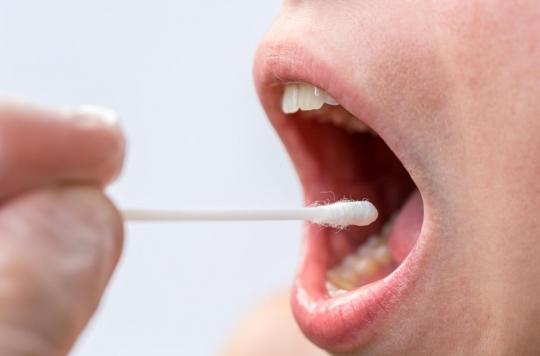Researchers have developed a saliva test to detect throat or mouth cancer. Their first tests are very promising.

Each year around the world, approximately 115,000 people are diagnosed with cancer of the throat or mouth, a oropharyngeal cancer (OPC). In Western countries, they are increasingly numerous, due to the increasing incidence of human papilloma (HPV)-16, the pathogenic strain associated with it, especially in young people. Unfortunately, these cancers are often diagnosed late, mainly because of their location, which makes them difficult to see during routine clinical examinations. However, a new study could now change the situation. A team of international researchers has succeeded in developing a non-invasive method to analyze saliva and detect the presence of human papilloma. This new technique, described in the Journal of Molecular Diagnostics, enabled them to detect the presence of OPC in saliva in 40% of the patients and tested. Among them, 80% were indeed sick.
For their study, the researchers analyzed saliva samples from ten patients who had received an HPV-OPC diagnosis using traditional methods (for throat cancer, a semi-flexible tube is inserted to explore the ducts and collect tissues). suspects for analysis). To do this, they used acoustofluidic technology, which merges acoustics and microfluidics. Liquid samples were analyzed using a tiny acoustofluidic chip created to isolate salivary exosomes by removing unwanted particles based on their size, leaving concentrated samples rich in exosomes, which facilitates the detection of tumor-specific biomarkers.
Exosomes are tiny microvesicles from cells secreted into body fluids. They probably play a role in intercellular communication and their high numbers are associated with several types of cancer.
A quick and inexpensive test to perform
Thanks to this method, the researchers succeeded in identifying the DNA of the HPV-16 tumor biomarker in 80% of cases. “The successful detection of HPV from isolated salivary exosomes by our acoustofluidic platform offers distinct advantages, including early detection, risk assessment and screening,” explains Tony Jun Huang, co-principal investigator in the Department of Engineering Mechanics and Materials Science from Duke University, Durham (USA).
In addition, the automated and rapid isolation of exosomes (less than five minutes compared to about eight hours of processing in normal times) allows inexpensive analyzes. In addition, this new test could also help doctors predict which patients will respond well to radiotherapy, for example. Finally, unlike traditional biopsy, it is perfectly suited to repeated and continuous monitoring of the progression of tumor treatment.
“With these features, acoustofluidic technology could far exceed current industry standards, address unmet needs in the field, help accelerate biomedical research on exosomes, and aid in the discovery of novel exosomal biomarkers” , adds Dr. Huang.
Tobacco, alcohol and HPV
“Liquid biopsy of the salivary exosome is an effective early detection and risk assessment approach for CPO,” said David TW Wong, researcher at the Center for Oral/Head and Neck Oncology Research, School of Dentistry at the University of California (Los Angeles, USA), who also participated in the study. saliva,” he continues.
Eventually, this technology could also be used to analyze other biofluids such as blood, urine and plasma, the researchers hope.
In France, throat cancer affects approximately 16,000 new people each year and 10,000 people for mouth cancer. Overall, men are much more affected than women, and the main risk factors are tobacco and chronic or heavy alcohol consumption. However, in recent years, the papillomavirus has also been increasingly involved. It would now be responsible for a third of cancers of the oral cavity. The association was established in 2007 by a study published in the New England Journal of Medicine : “Our data suggest that oral HPV infection is sexually acquired. Orogenital contact is strongly associated with oropharyngeal cancer,” the researchers note. According to them, the risk is increased by 32% when an HPV infection is diagnosed.

.

















